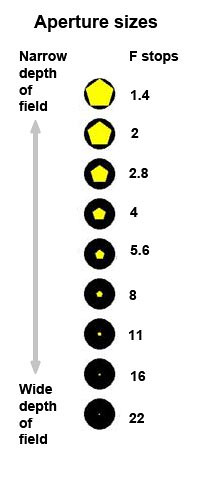![]()
Aperture

Diagram showing the relative aperture sizes against the F-stop numbers for each. A wide aperture also creates a shallow depth of field.
The term has two meanings:
- 1. The aperture is a hole in the ‘diaphragm‘ (a partition) in the camera lens. The size of the aperture controls the amount of light passing through the lens.
- 2. We use the term ‘aperture’ to describe the size of the opening when a picture is taken.
Aperture size
Size size of the hold is important. Each aperture size creates a different DoF. A wide aperture creates a shallow DoF – sharpness in a very slim band of the image. A tiny aperture creates a deep DoF – the picture is mostly/all sharp.
Aperture size can be controlled in a number of ways. In a DSLR it is normally controlled by overlapping blades in a fan-like arrangement around the aperture mounted on the diaphragm. See the ‘Iris Diaphragm‘.
Aperture size is expressed in numbers called f/stops. Low f/stop numbers indicate wider aperture openings. In the sequence that follows each succeeding f/stop halves the light through the aperture…
Wide: :Narrow f0.7; f1; F1.4; f2.8; f4; f5.6; f8; f11; f16; f22; f32;
The aperture size controls the ‘DoF‘, the range of sharpness in the image. As the aperture gets wider the depth of field gets shallower. A range of notional values for a 50mm prime lens might be:
| f/stop | Notional aperture | Notional DoF |
| 1.4 | Extremely wide open | Extremely shallow |
| 2 | Very Wide open | Very shallow |
| 2.8 | Wide open | Very shallow |
| 4 | Broad | Shallow |
| 5.6 | Medium | Medium |
| 8 | Narrowing | Local Area |
| 11 | Restricted opening | Long Distance |
| 16 | Tight opening | Far distance |
| 22 | Extremely restricted | Virtual infinity |
Aperture – can be measured in 1/3rd of a stop
Although the aperture size is measured in f/stops modern cameras allow great flexibility. Most modern lenses and cameras work on thirds of f/stops. So in the table above some of the stops are one third measures of a full stop. Your camera will probably have all the one third stops available for the whole range. The table is only a notional example. It only shows some settings as a guide.
